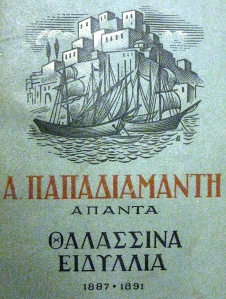
The University Library’s Modern Greek collection, which numbers over 13,000 items, is now represented on the Library’s language-specific webpages. An introduction to the collection, with an explanation about transliteration and a guide to history and literature classmarks, has been put up on this page. The text of that page is provided in this blog post.
The Modern Greek collection
The University Library has got over 13,000 items in Modern Greek in the electronic catalogue, stretching from the 16th century to the current day. The 16th to 18th centuries are represented by over 400 books in total, and then the 19th century sees a leap up to over 1,000 items. A greater leap still follows for the 20th century, with over 8,500. The 21st century is so far represented by nearly 3,000 books.
The status of Modern Greek in the University has changed in recent years. Having previously been a full Tripos (undergraduate degree) subject, it is now offered in the Faculty of Modern and Medieval Languages as a paper on language and culture which students can take as part of their main degree. The language’s standing has also changed in the University Library. The last dedicated (albeit part-time) Modern Greek specialist retired in 2010, and the budget for the language is lower now than in the past since precedence is given to languages still offered at the Tripos level. Responsibility for Modern Greek now rests with the Slavonic specialist.
The Modern Greek budget, such as it is, is spent primarily on subjects close to the paper still offered in the Faculty, which offers students “a sound and systematic introduction to the Modern Greek language, and the opportunity to acquaint themselves with key aspects of Greek culture from the late nineteenth century to the present” (quotation from the paper’s webpage). Books on literature and history are the most commonly bought.
Book recommendations can be sent to Mel Bach, the Slavonic specialist, at slavonic@lib.cam.ac.uk
Cataloguing (including Greek transliteration)
The University Library uses the Library of Congress transliteration system for Greek. A pdf version of the transliteration table is linked to here. The same document can be downloaded as a Word document from this page. As readers will see, some letters are treated differently according to their position in a word (for example the combination μπ is transliterated as b when it occurs at the beginning of the word, but as mp when it occurs in the middle or at the end). Some transliteration is altered according to the period of Greek in question. The letter β, for example, is transliterated as b for Ancient and Medieval Greek, but as v for Modern Greek.
The transliteration table is followed by explanatory notes and several pages of examples. Readers are strongly recommended to read this documentation.
Catalogue records for Modern Greek material processed since 2005 or so also include the original Greek script version of information such as the book’s title. It is not, however, possible to search in Greek script in any of the Library’s catalogues.
Classification
What follows is a very high-level guide to open-shelf classmarks for Greek history, literature, and linguistics. A much more detailed breakdown for these subjects can be found in the appropriate classification schemes (History and Geography, Western Literature, and Linguistics) on this page. Please note that very few books in Modern Greek are now placed into the open sequences; the majority are now given closed-access classmarks.
Greek history is covered by various classmarks in the North Front of the Library. Ancient and Byzantine Greek history is found on NF3 and NF4, at the following classmarks:
– 519 (Greece and Rome);
– 520 (Ancient Greek history);
– 522 (Greek antiquities); and
– 523 (Medieval Greece).
Modern Greek history is on NF6, in classmark 619, including:
– 619:16 (Ottoman rule);
– 619:2 (19th century);
– 619:3 (20th century); and
– 619:92-96 (local history).
Greek literature can be found in the Library’s North Wing, on NW2. The main classmarks for Classical Greek literature are as follows:
– 706 (Classical literature (works on both Greek and Latin));
– 707 (history and criticism);
– 708 (poetry);
– 709 (drama); and
– 710 (prose).
Medieval and Modern Greek literature are covered by the classmark 711 (also NW2), including:
– 711:3 (Medieval Greek);
– 711:5 (Modern Greek); and
– 711:7 (history and criticism).
The classmark guide then goes into great detail about the placement of scores of individual Classical Greek authors.
Books on the Greek language can be found on NW6 at 766.
Mel Bach

